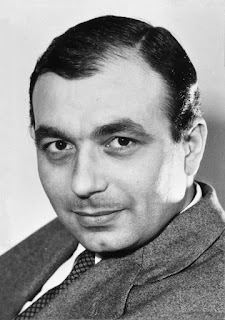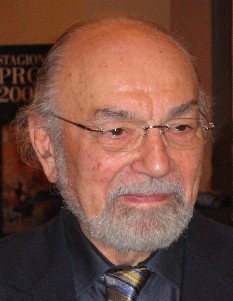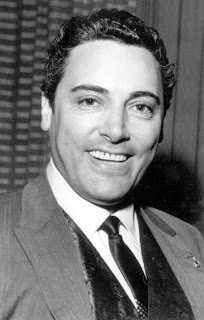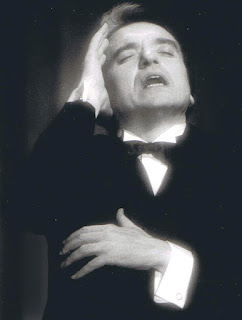Donizetti and Verdi specialist rated among greats
 |
| Renato Bruson, pictured not long after his debut in the 1960s. |
The opera singer Renato Bruson, whose interpretation of Giuseppe
Verdi’s baritone roles sometimes brought comparison with such redoubtable
performers as Tito Gobbi, Ettore Bastianini and Piero Cappuccili, was born on this
day in 1936 in the village of Granze, near Padua.
Bruson’s velvety voice and noble stage presence sustained
him over a career of remarkable longevity. He was still performing in 2011 at
the age of 75, having made his debut more than half a century earlier.
Since then he has devoted himself more to teaching masterclasses, although he did manage one more performance of Verdi’s Falstaff,
which was among his most famous roles, at the age of 77 in 2013, having been invited
to the Teatro Verdi in Busseto, the composer’s home town in Emilia-Romagna, as
part of a celebration marking 200 years since Verdi’s birth.
Today he is director of the Accademia Lirica at Teatro alla
Scala in Milan, a role he combines with a professorship at the Accademia Chigiana
in Siena and a post at the lyrical academy in Spoleto.
It was at the Teatro Lirico Sperimentale in Spoleto, the
ancient city in Umbria, that Bruson made his stage debut as the Conte di Luna in
Verdi’s Il trovatore in 1960, which was a moment that brought deep satisfaction
after a difficult childhood.
 |
| The parish church of Santa Cristina in Granze near Padua, where Bruson sang in the choir as a boy |
Therefore he was given little support from his family, even
though they had encouraged him to sing in the parish choir. Fortunately, he was
awarded a scholarship by the Conservatory of Padua, 30km (19 miles) away.
His debut in Spoleto was well received and he was soon
making his mark at some of the great opera houses of Italy, including the Teatro
dell’Opera in Rome (1961), La Fenice in Venice (1965) and the Teatro Massimo in
Palermo (1966).
 |
| The Teatro Regio in Parma, where Bruson was seen by a talent scout from the Met |
In the audience was Roberto Bauer, whose job was to scour
Europe looking for new talent for the Metropolitan Opera in New York. He was so impressed he sought out Bruson afterwards
so that he could arrange a meeting with the Met’s artistic director, Rudolf Bing. Two years later, Bruson was making his debut
on the other side of the Atlantic as Enrico in Gaetano Donizetti’s Lucia di
Lammermoor.
In the early part of his career, in particular, Bruson was
associated with Donizetti’s baritones as much as Verdi’s, performing in no
fewer than 17 operas from the pen of the Bergamo composer.
Over the next few years, Bruson paraded his acting skills, the
deep but smooth resonance of his voice and his commanding stage presence at
Europe’s leading opera houses.
Another milestone moment came in 1972 with his debut as
Antonio in Donizetti’s Linda di Chamounix at La Scala.
In 1975 he took his first bows at the Royal Opera House in
Covent Garden, London, as Renato in Verdi’s Un ballo in maschera, and in 1978
came his debut at the Vienna State Opera in Macbeth, the Shakespeare play upon
which Verdi had based his 10th opera in 1847.
 |
| Renato Bruson in more recent years |
Bruson is married to Tita Tegano, a costume and set designer
who has also written several books about the life and work of her husband. In
1996 he was made Knight of the Grand Cross of the Order of Merit of the Italian
Republic.
Last year, his career was celebrated again as he was named
as the recipient of the Caruso Prize in recognition of his lifetime contribution
to the opera genre. The award is made
annually in a ceremony at the Villa Caruso di Bellosguarda in Tuscany, former
home of the great Neapolitan tenor and now a museum.
The ancient city of Spoleto in Umbria, where Bruson made his
first appearance in a live opera performance, has a long association with music
and other performing arts, which it celebrates every summer with the Festival dei
Due Mondi, which sees events taking place in churches, theatres and open squares
throughout the city and attracts a high calibre of performers during June and
July. Spoleto also has some fine architecture, including a beautiful 12th-century
Duomo which has frescoes by Fra Filippo Lippi, who is buried in the church. The city also has the remains of a Roman amphiteatre and an imposing castle, parts of which go back to the fifth century.
The city of Padua’s biggest attraction is the beautiful
Scrovegni Chapel, made famous by the wonderful frescoes painted by Giotto, but
there is plenty more to the Veneto’s second largest city, including a wealth of
parks and gardens and a city centre where you will find many more students and
local people than tourists. This is
despite Padua boasting the two fine basilicas of Sant’Antonio and Santa Giustina,
the oval piazza known as Prato della Valle, the historic centre built around
the Duomo, the Palazzo della Ragione and a University established in 1222 at
which Galileo Galilei was a lecturer.








